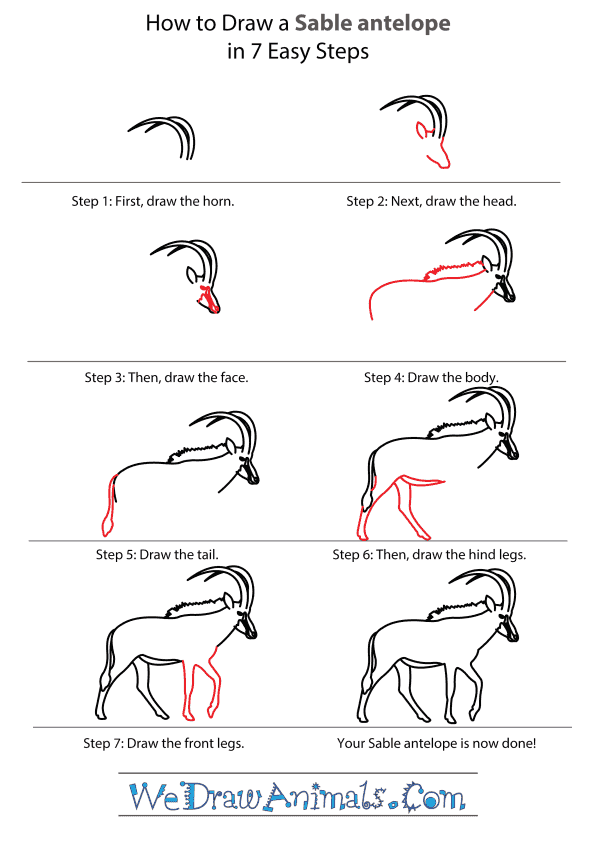In this quick tutorial you'll learn how to draw a Sable Antelope in 7 easy steps - great for kids and novice artists.
The images above represent how your finished drawing is going to look and the steps involved.
Below are the individual steps - you can click on each one for a High Resolution printable PDF version.
At the bottom you can read some interesting facts about the Sable Antelope.
Make sure you also check out any of the hundreds of drawing tutorials grouped by category.
How to Draw a Sable Antelope - Step-by-Step Tutorial
Step 1: Let's start with the horn. It is curved almost like a fishing hook, and has a sharp point at the end. These sable antelope can fight lions, and win, with that horn!
Step 2: Then draw the U shaped head. Add an ear near the horn. It looks like a leaf.
Step 3: Now draw the facial markings, and give your antelope an eye.
Step 4: Add the neck and body lines. Give your antelope a mane that starts behind the ear and goes halfway down the body.
Step 5: Next, draw the tail. It looks a lot like a tadpole, doesn't it? It is an excellent flyswatter.
Step 6: Let's add the back legs. They are strong and thin so he can run through the grasslands they call home.
Step 7: Finally, add the front legs. If you are having trouble, drawing straight lines will look great, too. Your sable antelope is now done! If you'd like to color yours, these are the darkest antelope. They are dark brown or black, with white patches on the face.
Interesting Facts about the Sable Antelope
The sable antelope (Hippotragus niger) in an antelope that is found in Eastern and Southern Africa. There are four different types of sable antelope; the eastern sable, the common sable, the Giant sable and the Black sable.
Did you know?
- The male sable antelope is heavier and taller than the female.
- Females and younger sable antelope are chestnut to dark brown colored, and males begin to turn black after three years. Color seems to be related to hormones, as castrated males will begin to revert back to a brown color.
- Both males and females have horns, but the male horns are much thicker and long, growing up to five feet long.
- Herds consist of 15 to 25 females and one alpha male. The young remain with their herds until about three years old, when the males will be driven out.
- Young males join bachelor herds of two to five other males until they are ready to breed at five years, when they will branch off to attract females and build their own herds.
Lesson plan note: Discuss the sable antelope’s ability to change coat color depending on its hormones, and how it can be useful in showing its breeding and social status to other antelope.








